Reducing Complexity in Declarative Process Mining: An Analysis Report
VerifiedAdded on 2021/05/30
|8
|2413
|184
Report
AI Summary
This report provides an analysis of the article "Declarative Process Mining: Reducing Discovered Models Complexity by Pre-Processing Event Logs" by Richetti et al. (2014). The paper explores declarative process mining techniques, which aim to extract knowledge from procedures stored by information systems, and their application in business process management. The report examines the authors' intentions, research methods, findings, and comparisons with other research in the field. Richetti et al. propose a method to reduce the complexity of declarative models by grouping activities based on inclusion and hierarchy semantic relations, using algorithms and a case study. The analysis highlights the authors' findings regarding the reduction of actions and constraints, and the identification of potential activity aggregations. The report also notes the absence of major problems highlighted by Richetti et al. and contrasts this with the challenges reported by other researchers, such as those related to procedural process approaches and algorithm development. The conclusion summarizes the research, findings, and recommendations for future work in the field of declarative process mining. The article is an informative piece, and a great contribution to the subject of declarative process mining.
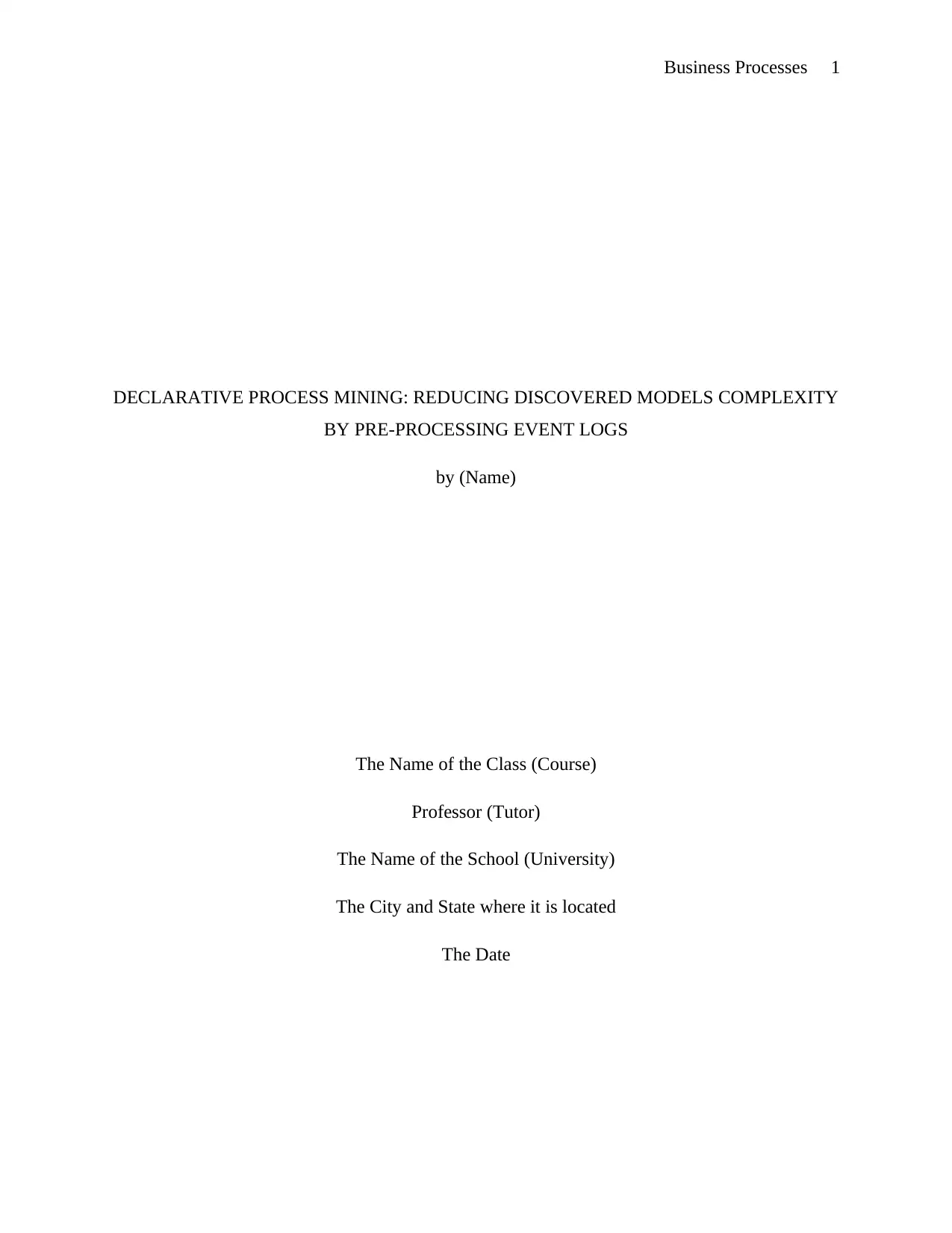
Business Processes 1
DECLARATIVE PROCESS MINING: REDUCING DISCOVERED MODELS COMPLEXITY
BY PRE-PROCESSING EVENT LOGS
by (Name)
The Name of the Class (Course)
Professor (Tutor)
The Name of the School (University)
The City and State where it is located
The Date
DECLARATIVE PROCESS MINING: REDUCING DISCOVERED MODELS COMPLEXITY
BY PRE-PROCESSING EVENT LOGS
by (Name)
The Name of the Class (Course)
Professor (Tutor)
The Name of the School (University)
The City and State where it is located
The Date
Paraphrase This Document
Need a fresh take? Get an instant paraphrase of this document with our AI Paraphraser
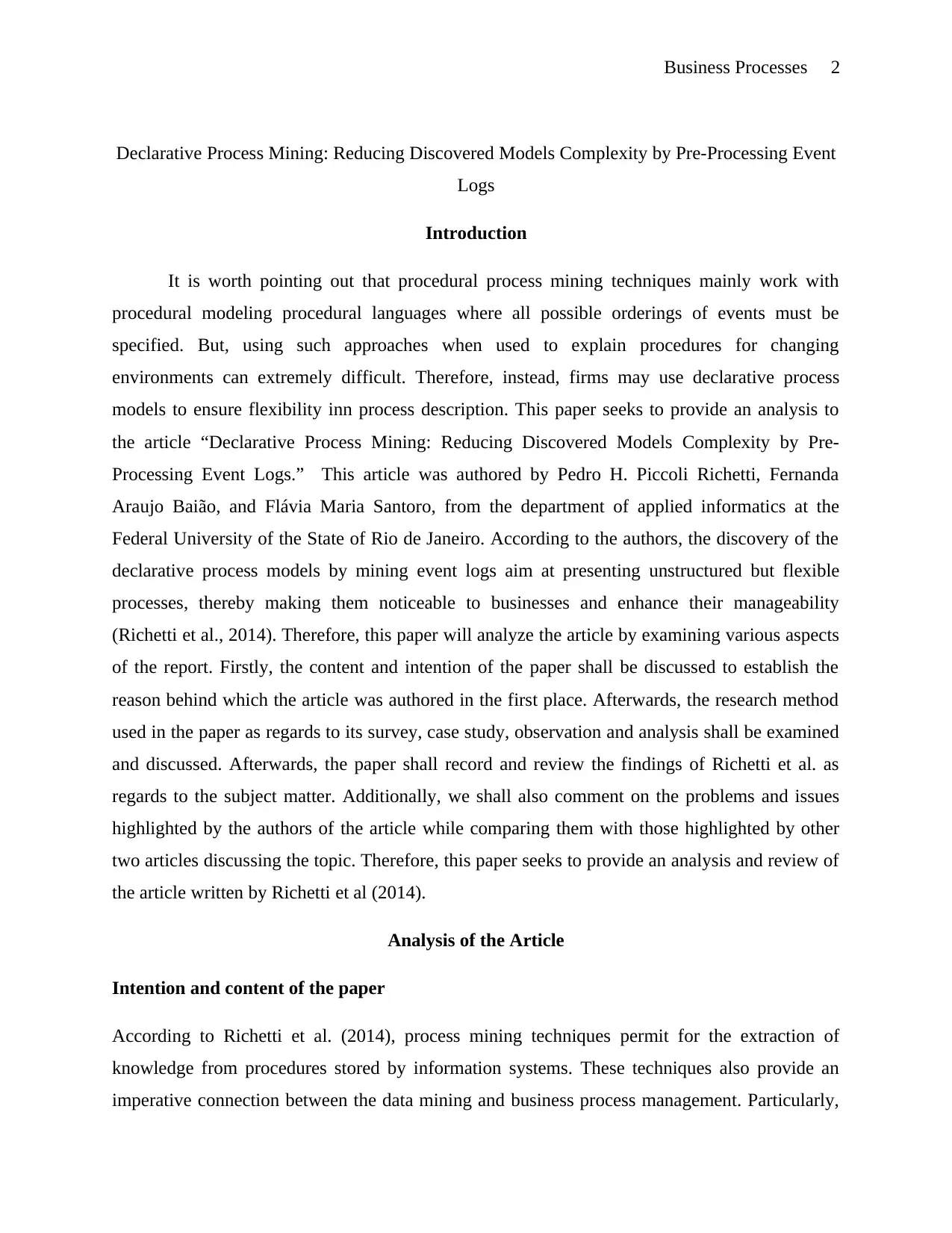
Business Processes 2
Declarative Process Mining: Reducing Discovered Models Complexity by Pre-Processing Event
Logs
Introduction
It is worth pointing out that procedural process mining techniques mainly work with
procedural modeling procedural languages where all possible orderings of events must be
specified. But, using such approaches when used to explain procedures for changing
environments can extremely difficult. Therefore, instead, firms may use declarative process
models to ensure flexibility inn process description. This paper seeks to provide an analysis to
the article “Declarative Process Mining: Reducing Discovered Models Complexity by Pre-
Processing Event Logs.” This article was authored by Pedro H. Piccoli Richetti, Fernanda
Araujo Baião, and Flávia Maria Santoro, from the department of applied informatics at the
Federal University of the State of Rio de Janeiro. According to the authors, the discovery of the
declarative process models by mining event logs aim at presenting unstructured but flexible
processes, thereby making them noticeable to businesses and enhance their manageability
(Richetti et al., 2014). Therefore, this paper will analyze the article by examining various aspects
of the report. Firstly, the content and intention of the paper shall be discussed to establish the
reason behind which the article was authored in the first place. Afterwards, the research method
used in the paper as regards to its survey, case study, observation and analysis shall be examined
and discussed. Afterwards, the paper shall record and review the findings of Richetti et al. as
regards to the subject matter. Additionally, we shall also comment on the problems and issues
highlighted by the authors of the article while comparing them with those highlighted by other
two articles discussing the topic. Therefore, this paper seeks to provide an analysis and review of
the article written by Richetti et al (2014).
Analysis of the Article
Intention and content of the paper
According to Richetti et al. (2014), process mining techniques permit for the extraction of
knowledge from procedures stored by information systems. These techniques also provide an
imperative connection between the data mining and business process management. Particularly,
Declarative Process Mining: Reducing Discovered Models Complexity by Pre-Processing Event
Logs
Introduction
It is worth pointing out that procedural process mining techniques mainly work with
procedural modeling procedural languages where all possible orderings of events must be
specified. But, using such approaches when used to explain procedures for changing
environments can extremely difficult. Therefore, instead, firms may use declarative process
models to ensure flexibility inn process description. This paper seeks to provide an analysis to
the article “Declarative Process Mining: Reducing Discovered Models Complexity by Pre-
Processing Event Logs.” This article was authored by Pedro H. Piccoli Richetti, Fernanda
Araujo Baião, and Flávia Maria Santoro, from the department of applied informatics at the
Federal University of the State of Rio de Janeiro. According to the authors, the discovery of the
declarative process models by mining event logs aim at presenting unstructured but flexible
processes, thereby making them noticeable to businesses and enhance their manageability
(Richetti et al., 2014). Therefore, this paper will analyze the article by examining various aspects
of the report. Firstly, the content and intention of the paper shall be discussed to establish the
reason behind which the article was authored in the first place. Afterwards, the research method
used in the paper as regards to its survey, case study, observation and analysis shall be examined
and discussed. Afterwards, the paper shall record and review the findings of Richetti et al. as
regards to the subject matter. Additionally, we shall also comment on the problems and issues
highlighted by the authors of the article while comparing them with those highlighted by other
two articles discussing the topic. Therefore, this paper seeks to provide an analysis and review of
the article written by Richetti et al (2014).
Analysis of the Article
Intention and content of the paper
According to Richetti et al. (2014), process mining techniques permit for the extraction of
knowledge from procedures stored by information systems. These techniques also provide an
imperative connection between the data mining and business process management. Particularly,
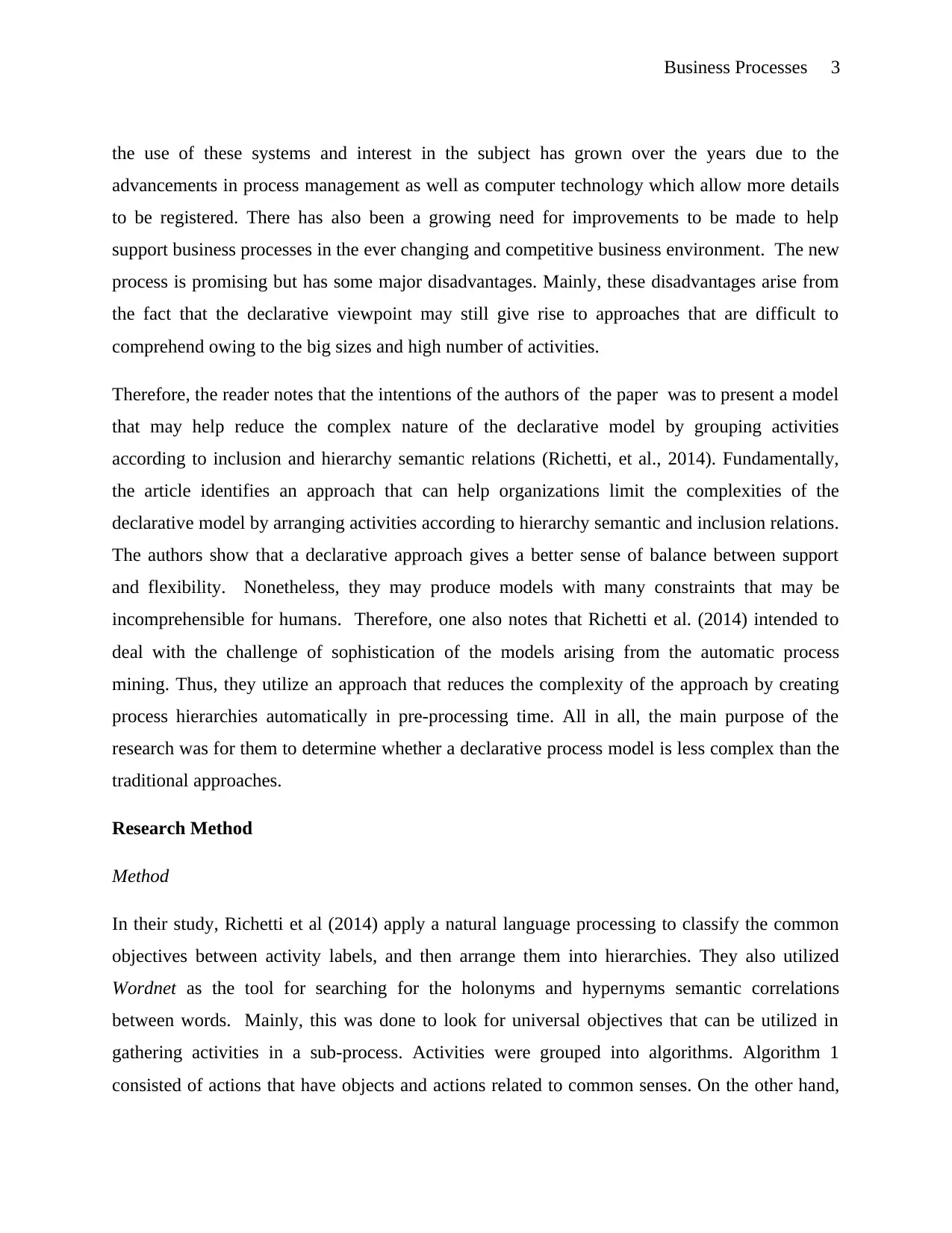
Business Processes 3
the use of these systems and interest in the subject has grown over the years due to the
advancements in process management as well as computer technology which allow more details
to be registered. There has also been a growing need for improvements to be made to help
support business processes in the ever changing and competitive business environment. The new
process is promising but has some major disadvantages. Mainly, these disadvantages arise from
the fact that the declarative viewpoint may still give rise to approaches that are difficult to
comprehend owing to the big sizes and high number of activities.
Therefore, the reader notes that the intentions of the authors of the paper was to present a model
that may help reduce the complex nature of the declarative model by grouping activities
according to inclusion and hierarchy semantic relations (Richetti, et al., 2014). Fundamentally,
the article identifies an approach that can help organizations limit the complexities of the
declarative model by arranging activities according to hierarchy semantic and inclusion relations.
The authors show that a declarative approach gives a better sense of balance between support
and flexibility. Nonetheless, they may produce models with many constraints that may be
incomprehensible for humans. Therefore, one also notes that Richetti et al. (2014) intended to
deal with the challenge of sophistication of the models arising from the automatic process
mining. Thus, they utilize an approach that reduces the complexity of the approach by creating
process hierarchies automatically in pre-processing time. All in all, the main purpose of the
research was for them to determine whether a declarative process model is less complex than the
traditional approaches.
Research Method
Method
In their study, Richetti et al (2014) apply a natural language processing to classify the common
objectives between activity labels, and then arrange them into hierarchies. They also utilized
Wordnet as the tool for searching for the holonyms and hypernyms semantic correlations
between words. Mainly, this was done to look for universal objectives that can be utilized in
gathering activities in a sub-process. Activities were grouped into algorithms. Algorithm 1
consisted of actions that have objects and actions related to common senses. On the other hand,
the use of these systems and interest in the subject has grown over the years due to the
advancements in process management as well as computer technology which allow more details
to be registered. There has also been a growing need for improvements to be made to help
support business processes in the ever changing and competitive business environment. The new
process is promising but has some major disadvantages. Mainly, these disadvantages arise from
the fact that the declarative viewpoint may still give rise to approaches that are difficult to
comprehend owing to the big sizes and high number of activities.
Therefore, the reader notes that the intentions of the authors of the paper was to present a model
that may help reduce the complex nature of the declarative model by grouping activities
according to inclusion and hierarchy semantic relations (Richetti, et al., 2014). Fundamentally,
the article identifies an approach that can help organizations limit the complexities of the
declarative model by arranging activities according to hierarchy semantic and inclusion relations.
The authors show that a declarative approach gives a better sense of balance between support
and flexibility. Nonetheless, they may produce models with many constraints that may be
incomprehensible for humans. Therefore, one also notes that Richetti et al. (2014) intended to
deal with the challenge of sophistication of the models arising from the automatic process
mining. Thus, they utilize an approach that reduces the complexity of the approach by creating
process hierarchies automatically in pre-processing time. All in all, the main purpose of the
research was for them to determine whether a declarative process model is less complex than the
traditional approaches.
Research Method
Method
In their study, Richetti et al (2014) apply a natural language processing to classify the common
objectives between activity labels, and then arrange them into hierarchies. They also utilized
Wordnet as the tool for searching for the holonyms and hypernyms semantic correlations
between words. Mainly, this was done to look for universal objectives that can be utilized in
gathering activities in a sub-process. Activities were grouped into algorithms. Algorithm 1
consisted of actions that have objects and actions related to common senses. On the other hand,
⊘ This is a preview!⊘
Do you want full access?
Subscribe today to unlock all pages.

Trusted by 1+ million students worldwide
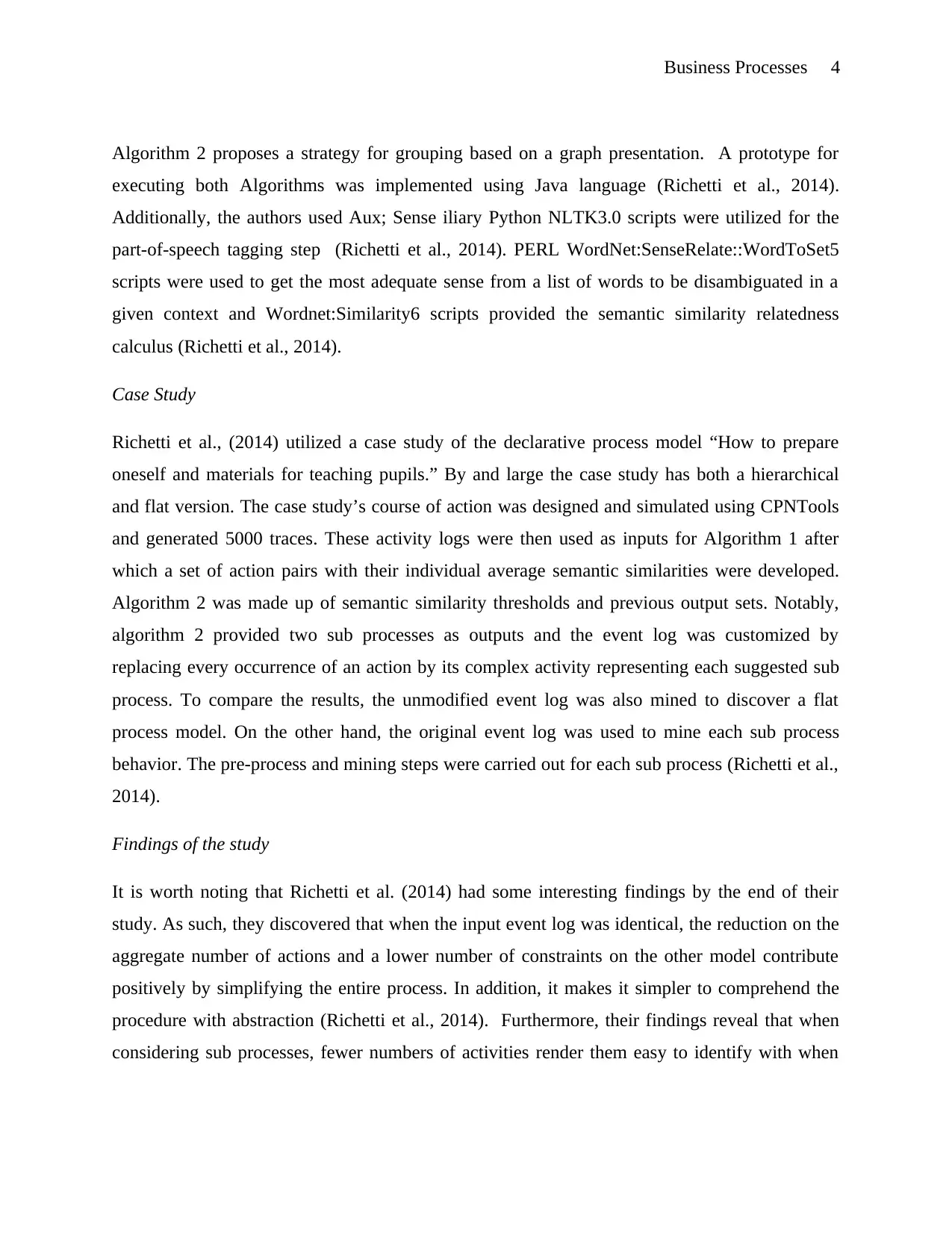
Business Processes 4
Algorithm 2 proposes a strategy for grouping based on a graph presentation. A prototype for
executing both Algorithms was implemented using Java language (Richetti et al., 2014).
Additionally, the authors used Aux; Sense iliary Python NLTK3.0 scripts were utilized for the
part-of-speech tagging step (Richetti et al., 2014). PERL WordNet:SenseRelate::WordToSet5
scripts were used to get the most adequate sense from a list of words to be disambiguated in a
given context and Wordnet:Similarity6 scripts provided the semantic similarity relatedness
calculus (Richetti et al., 2014).
Case Study
Richetti et al., (2014) utilized a case study of the declarative process model “How to prepare
oneself and materials for teaching pupils.” By and large the case study has both a hierarchical
and flat version. The case study’s course of action was designed and simulated using CPNTools
and generated 5000 traces. These activity logs were then used as inputs for Algorithm 1 after
which a set of action pairs with their individual average semantic similarities were developed.
Algorithm 2 was made up of semantic similarity thresholds and previous output sets. Notably,
algorithm 2 provided two sub processes as outputs and the event log was customized by
replacing every occurrence of an action by its complex activity representing each suggested sub
process. To compare the results, the unmodified event log was also mined to discover a flat
process model. On the other hand, the original event log was used to mine each sub process
behavior. The pre-process and mining steps were carried out for each sub process (Richetti et al.,
2014).
Findings of the study
It is worth noting that Richetti et al. (2014) had some interesting findings by the end of their
study. As such, they discovered that when the input event log was identical, the reduction on the
aggregate number of actions and a lower number of constraints on the other model contribute
positively by simplifying the entire process. In addition, it makes it simpler to comprehend the
procedure with abstraction (Richetti et al., 2014). Furthermore, their findings reveal that when
considering sub processes, fewer numbers of activities render them easy to identify with when
Algorithm 2 proposes a strategy for grouping based on a graph presentation. A prototype for
executing both Algorithms was implemented using Java language (Richetti et al., 2014).
Additionally, the authors used Aux; Sense iliary Python NLTK3.0 scripts were utilized for the
part-of-speech tagging step (Richetti et al., 2014). PERL WordNet:SenseRelate::WordToSet5
scripts were used to get the most adequate sense from a list of words to be disambiguated in a
given context and Wordnet:Similarity6 scripts provided the semantic similarity relatedness
calculus (Richetti et al., 2014).
Case Study
Richetti et al., (2014) utilized a case study of the declarative process model “How to prepare
oneself and materials for teaching pupils.” By and large the case study has both a hierarchical
and flat version. The case study’s course of action was designed and simulated using CPNTools
and generated 5000 traces. These activity logs were then used as inputs for Algorithm 1 after
which a set of action pairs with their individual average semantic similarities were developed.
Algorithm 2 was made up of semantic similarity thresholds and previous output sets. Notably,
algorithm 2 provided two sub processes as outputs and the event log was customized by
replacing every occurrence of an action by its complex activity representing each suggested sub
process. To compare the results, the unmodified event log was also mined to discover a flat
process model. On the other hand, the original event log was used to mine each sub process
behavior. The pre-process and mining steps were carried out for each sub process (Richetti et al.,
2014).
Findings of the study
It is worth noting that Richetti et al. (2014) had some interesting findings by the end of their
study. As such, they discovered that when the input event log was identical, the reduction on the
aggregate number of actions and a lower number of constraints on the other model contribute
positively by simplifying the entire process. In addition, it makes it simpler to comprehend the
procedure with abstraction (Richetti et al., 2014). Furthermore, their findings reveal that when
considering sub processes, fewer numbers of activities render them easy to identify with when
Paraphrase This Document
Need a fresh take? Get an instant paraphrase of this document with our AI Paraphraser
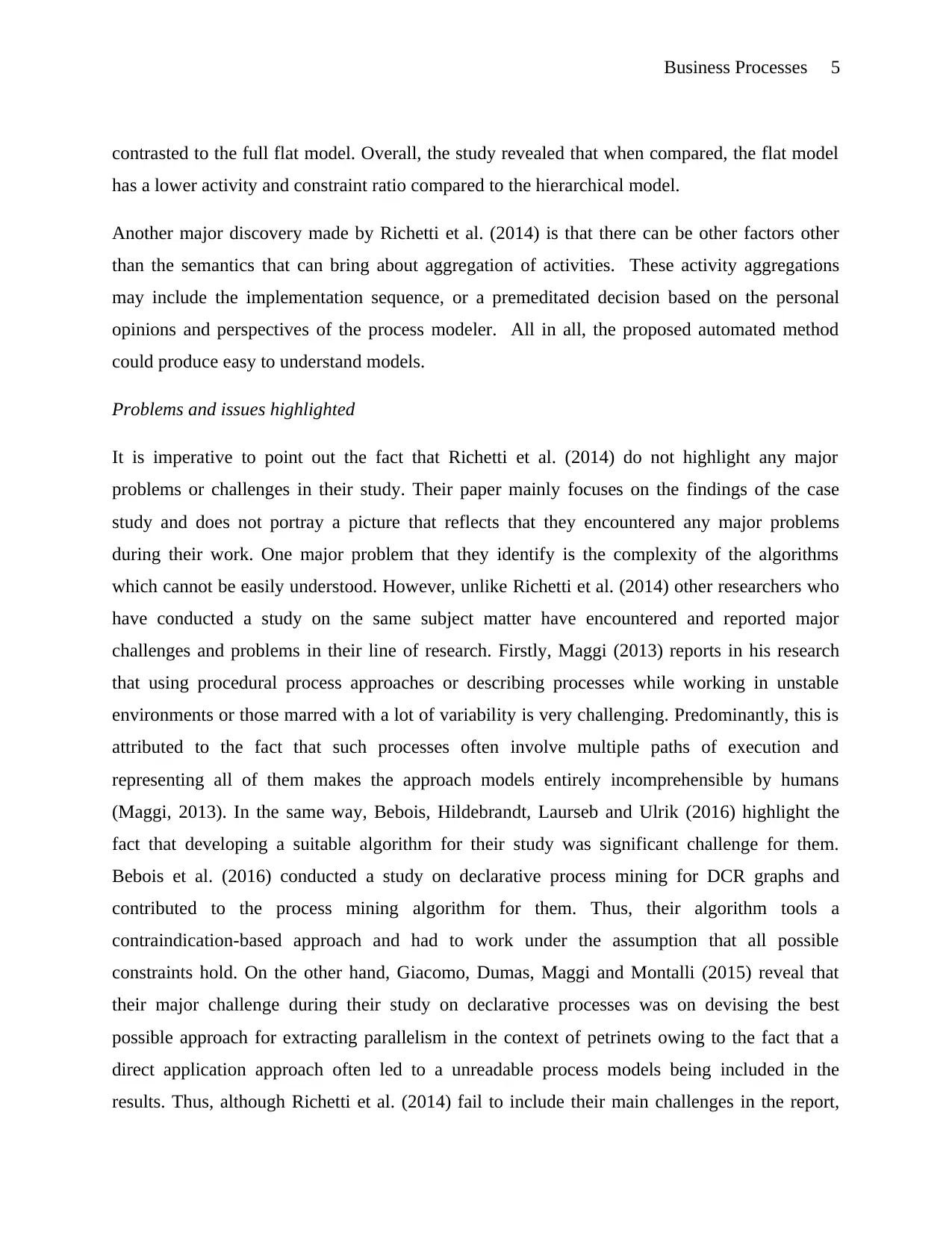
Business Processes 5
contrasted to the full flat model. Overall, the study revealed that when compared, the flat model
has a lower activity and constraint ratio compared to the hierarchical model.
Another major discovery made by Richetti et al. (2014) is that there can be other factors other
than the semantics that can bring about aggregation of activities. These activity aggregations
may include the implementation sequence, or a premeditated decision based on the personal
opinions and perspectives of the process modeler. All in all, the proposed automated method
could produce easy to understand models.
Problems and issues highlighted
It is imperative to point out the fact that Richetti et al. (2014) do not highlight any major
problems or challenges in their study. Their paper mainly focuses on the findings of the case
study and does not portray a picture that reflects that they encountered any major problems
during their work. One major problem that they identify is the complexity of the algorithms
which cannot be easily understood. However, unlike Richetti et al. (2014) other researchers who
have conducted a study on the same subject matter have encountered and reported major
challenges and problems in their line of research. Firstly, Maggi (2013) reports in his research
that using procedural process approaches or describing processes while working in unstable
environments or those marred with a lot of variability is very challenging. Predominantly, this is
attributed to the fact that such processes often involve multiple paths of execution and
representing all of them makes the approach models entirely incomprehensible by humans
(Maggi, 2013). In the same way, Bebois, Hildebrandt, Laurseb and Ulrik (2016) highlight the
fact that developing a suitable algorithm for their study was significant challenge for them.
Bebois et al. (2016) conducted a study on declarative process mining for DCR graphs and
contributed to the process mining algorithm for them. Thus, their algorithm tools a
contraindication-based approach and had to work under the assumption that all possible
constraints hold. On the other hand, Giacomo, Dumas, Maggi and Montalli (2015) reveal that
their major challenge during their study on declarative processes was on devising the best
possible approach for extracting parallelism in the context of petrinets owing to the fact that a
direct application approach often led to a unreadable process models being included in the
results. Thus, although Richetti et al. (2014) fail to include their main challenges in the report,
contrasted to the full flat model. Overall, the study revealed that when compared, the flat model
has a lower activity and constraint ratio compared to the hierarchical model.
Another major discovery made by Richetti et al. (2014) is that there can be other factors other
than the semantics that can bring about aggregation of activities. These activity aggregations
may include the implementation sequence, or a premeditated decision based on the personal
opinions and perspectives of the process modeler. All in all, the proposed automated method
could produce easy to understand models.
Problems and issues highlighted
It is imperative to point out the fact that Richetti et al. (2014) do not highlight any major
problems or challenges in their study. Their paper mainly focuses on the findings of the case
study and does not portray a picture that reflects that they encountered any major problems
during their work. One major problem that they identify is the complexity of the algorithms
which cannot be easily understood. However, unlike Richetti et al. (2014) other researchers who
have conducted a study on the same subject matter have encountered and reported major
challenges and problems in their line of research. Firstly, Maggi (2013) reports in his research
that using procedural process approaches or describing processes while working in unstable
environments or those marred with a lot of variability is very challenging. Predominantly, this is
attributed to the fact that such processes often involve multiple paths of execution and
representing all of them makes the approach models entirely incomprehensible by humans
(Maggi, 2013). In the same way, Bebois, Hildebrandt, Laurseb and Ulrik (2016) highlight the
fact that developing a suitable algorithm for their study was significant challenge for them.
Bebois et al. (2016) conducted a study on declarative process mining for DCR graphs and
contributed to the process mining algorithm for them. Thus, their algorithm tools a
contraindication-based approach and had to work under the assumption that all possible
constraints hold. On the other hand, Giacomo, Dumas, Maggi and Montalli (2015) reveal that
their major challenge during their study on declarative processes was on devising the best
possible approach for extracting parallelism in the context of petrinets owing to the fact that a
direct application approach often led to a unreadable process models being included in the
results. Thus, although Richetti et al. (2014) fail to include their main challenges in the report,
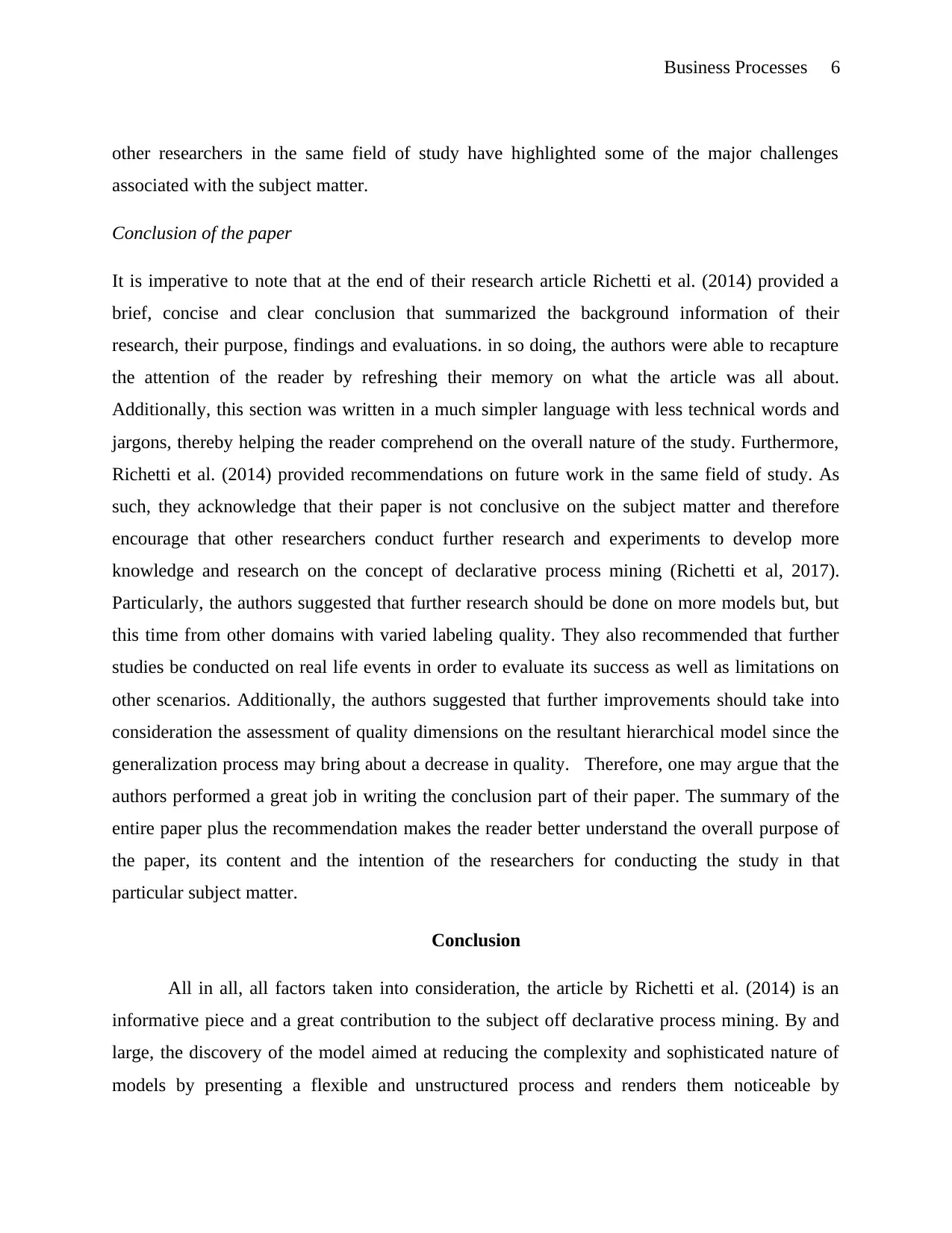
Business Processes 6
other researchers in the same field of study have highlighted some of the major challenges
associated with the subject matter.
Conclusion of the paper
It is imperative to note that at the end of their research article Richetti et al. (2014) provided a
brief, concise and clear conclusion that summarized the background information of their
research, their purpose, findings and evaluations. in so doing, the authors were able to recapture
the attention of the reader by refreshing their memory on what the article was all about.
Additionally, this section was written in a much simpler language with less technical words and
jargons, thereby helping the reader comprehend on the overall nature of the study. Furthermore,
Richetti et al. (2014) provided recommendations on future work in the same field of study. As
such, they acknowledge that their paper is not conclusive on the subject matter and therefore
encourage that other researchers conduct further research and experiments to develop more
knowledge and research on the concept of declarative process mining (Richetti et al, 2017).
Particularly, the authors suggested that further research should be done on more models but, but
this time from other domains with varied labeling quality. They also recommended that further
studies be conducted on real life events in order to evaluate its success as well as limitations on
other scenarios. Additionally, the authors suggested that further improvements should take into
consideration the assessment of quality dimensions on the resultant hierarchical model since the
generalization process may bring about a decrease in quality. Therefore, one may argue that the
authors performed a great job in writing the conclusion part of their paper. The summary of the
entire paper plus the recommendation makes the reader better understand the overall purpose of
the paper, its content and the intention of the researchers for conducting the study in that
particular subject matter.
Conclusion
All in all, all factors taken into consideration, the article by Richetti et al. (2014) is an
informative piece and a great contribution to the subject off declarative process mining. By and
large, the discovery of the model aimed at reducing the complexity and sophisticated nature of
models by presenting a flexible and unstructured process and renders them noticeable by
other researchers in the same field of study have highlighted some of the major challenges
associated with the subject matter.
Conclusion of the paper
It is imperative to note that at the end of their research article Richetti et al. (2014) provided a
brief, concise and clear conclusion that summarized the background information of their
research, their purpose, findings and evaluations. in so doing, the authors were able to recapture
the attention of the reader by refreshing their memory on what the article was all about.
Additionally, this section was written in a much simpler language with less technical words and
jargons, thereby helping the reader comprehend on the overall nature of the study. Furthermore,
Richetti et al. (2014) provided recommendations on future work in the same field of study. As
such, they acknowledge that their paper is not conclusive on the subject matter and therefore
encourage that other researchers conduct further research and experiments to develop more
knowledge and research on the concept of declarative process mining (Richetti et al, 2017).
Particularly, the authors suggested that further research should be done on more models but, but
this time from other domains with varied labeling quality. They also recommended that further
studies be conducted on real life events in order to evaluate its success as well as limitations on
other scenarios. Additionally, the authors suggested that further improvements should take into
consideration the assessment of quality dimensions on the resultant hierarchical model since the
generalization process may bring about a decrease in quality. Therefore, one may argue that the
authors performed a great job in writing the conclusion part of their paper. The summary of the
entire paper plus the recommendation makes the reader better understand the overall purpose of
the paper, its content and the intention of the researchers for conducting the study in that
particular subject matter.
Conclusion
All in all, all factors taken into consideration, the article by Richetti et al. (2014) is an
informative piece and a great contribution to the subject off declarative process mining. By and
large, the discovery of the model aimed at reducing the complexity and sophisticated nature of
models by presenting a flexible and unstructured process and renders them noticeable by
⊘ This is a preview!⊘
Do you want full access?
Subscribe today to unlock all pages.

Trusted by 1+ million students worldwide
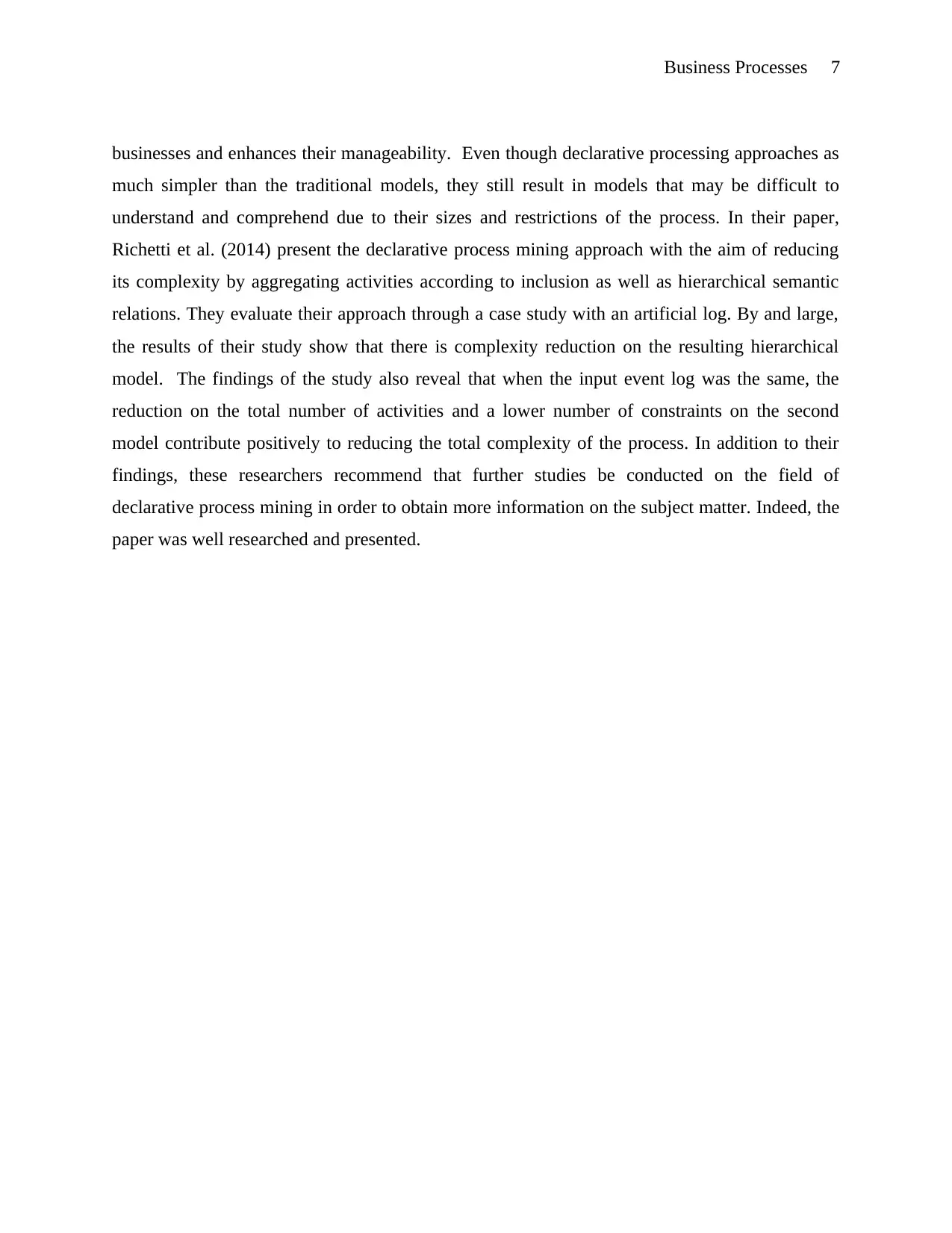
Business Processes 7
businesses and enhances their manageability. Even though declarative processing approaches as
much simpler than the traditional models, they still result in models that may be difficult to
understand and comprehend due to their sizes and restrictions of the process. In their paper,
Richetti et al. (2014) present the declarative process mining approach with the aim of reducing
its complexity by aggregating activities according to inclusion as well as hierarchical semantic
relations. They evaluate their approach through a case study with an artificial log. By and large,
the results of their study show that there is complexity reduction on the resulting hierarchical
model. The findings of the study also reveal that when the input event log was the same, the
reduction on the total number of activities and a lower number of constraints on the second
model contribute positively to reducing the total complexity of the process. In addition to their
findings, these researchers recommend that further studies be conducted on the field of
declarative process mining in order to obtain more information on the subject matter. Indeed, the
paper was well researched and presented.
businesses and enhances their manageability. Even though declarative processing approaches as
much simpler than the traditional models, they still result in models that may be difficult to
understand and comprehend due to their sizes and restrictions of the process. In their paper,
Richetti et al. (2014) present the declarative process mining approach with the aim of reducing
its complexity by aggregating activities according to inclusion as well as hierarchical semantic
relations. They evaluate their approach through a case study with an artificial log. By and large,
the results of their study show that there is complexity reduction on the resulting hierarchical
model. The findings of the study also reveal that when the input event log was the same, the
reduction on the total number of activities and a lower number of constraints on the second
model contribute positively to reducing the total complexity of the process. In addition to their
findings, these researchers recommend that further studies be conducted on the field of
declarative process mining in order to obtain more information on the subject matter. Indeed, the
paper was well researched and presented.
Paraphrase This Document
Need a fresh take? Get an instant paraphrase of this document with our AI Paraphraser
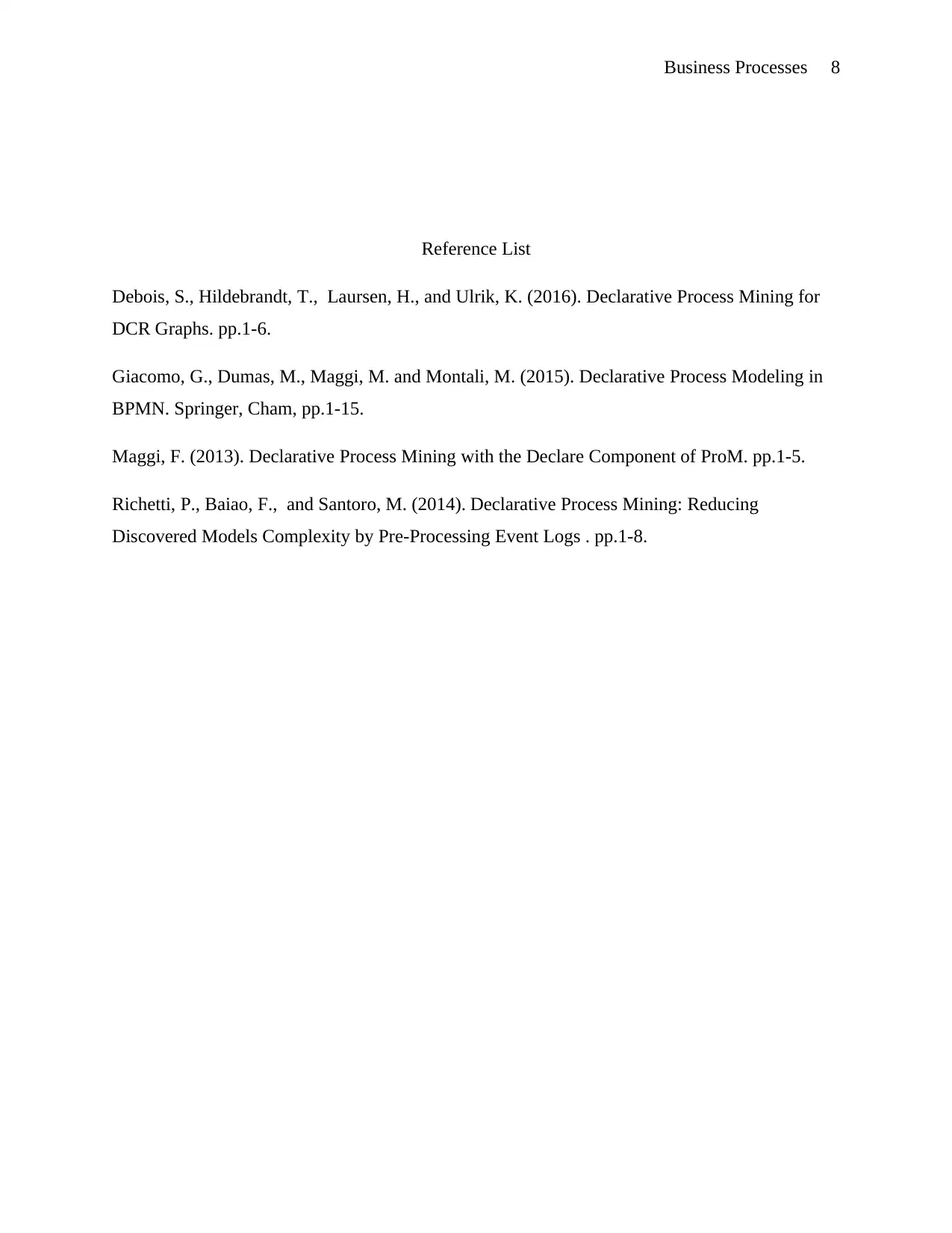
Business Processes 8
Reference List
Debois, S., Hildebrandt, T., Laursen, H., and Ulrik, K. (2016). Declarative Process Mining for
DCR Graphs. pp.1-6.
Giacomo, G., Dumas, M., Maggi, M. and Montali, M. (2015). Declarative Process Modeling in
BPMN. Springer, Cham, pp.1-15.
Maggi, F. (2013). Declarative Process Mining with the Declare Component of ProM. pp.1-5.
Richetti, P., Baiao, F., and Santoro, M. (2014). Declarative Process Mining: Reducing
Discovered Models Complexity by Pre-Processing Event Logs . pp.1-8.
Reference List
Debois, S., Hildebrandt, T., Laursen, H., and Ulrik, K. (2016). Declarative Process Mining for
DCR Graphs. pp.1-6.
Giacomo, G., Dumas, M., Maggi, M. and Montali, M. (2015). Declarative Process Modeling in
BPMN. Springer, Cham, pp.1-15.
Maggi, F. (2013). Declarative Process Mining with the Declare Component of ProM. pp.1-5.
Richetti, P., Baiao, F., and Santoro, M. (2014). Declarative Process Mining: Reducing
Discovered Models Complexity by Pre-Processing Event Logs . pp.1-8.
1 out of 8
Related Documents
Your All-in-One AI-Powered Toolkit for Academic Success.
+13062052269
info@desklib.com
Available 24*7 on WhatsApp / Email
![[object Object]](/_next/static/media/star-bottom.7253800d.svg)
Unlock your academic potential
Copyright © 2020–2025 A2Z Services. All Rights Reserved. Developed and managed by ZUCOL.





